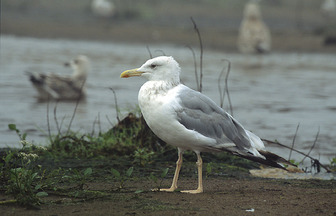Caspian gull
It is a large gull with a long, slender bill, accentuated by the sloping forehead. The legs, wings and neck are longer than those of the Herring Gull and Yellow-legged Gull. The eye is small and often dark, the legs vary from pale pink to a pale yellowish colour. The back and wings are a slightly darker shade of grey than the Herring Gull but slightly paler than the Yellow-legged Gull. The outermost primary feather has a large white tip and a white tongue running up the inner web.

Original source: Own work
Author: Marek Szczepanek
Permission: GNU Free Documentation License
The Caspian gull is classified as Least Concern. Does not qualify for a more at risk category. Widespread and abundant taxa are included in this category.
Caspian Gull is a name applied to the gull taxon Larus (argentatus) cachinnans, a member of the Herring Gull/Lesser Black-backed Gull complex. More
Caspian GullDistribution The Caspian Gull breeds around the Black and Caspian Seas, extending eastwards across Central Asia to north-west China. In Europe it has been spreading north and west and now breeds in Poland and eastern Germany. Some birds migrate south as far as the Red Sea and Persian Gulf while others disperse into Western Europe, in such countries as Norway and Denmark. Small numbers are now seen regularly in Britain, especially in South-east England, East Anglia and the Midlands. More
This article describes the identification of Caspian Gull, a bird that occurs regularly at inland rubbish tips and gull roosts, but is perhaps under-recorded due to limited awareness of identification criteria. The distinguishing features separating Caspian Gull from commoner gulls are somewhat subtle, and there are pitfalls due to the variability of gulls in size, plumage and bare part colouration, but when good views are obtained it is a distinctive gull and is not exceptionally difficult to identify. More
Caspian Gull - Near Adult winter, Hole Haven Creek7th February 2008Again same bird as above but here in direct comparison with 'white-headed' adult Herring Gulls. Most noticeable differences are the slightly darker grey upper-parts; the small rounded head (due to angle); extremely small dark beady eye; lemony bill colour though the lower Herring Gull is very similar in this respect; the long primary projection, the pushed out breast and the very long pasty coloured legs. More
Caspian Gull when sat on the water. As the wings are rather long on Caspian Gulls they have a tendancy to appear higher from the waters surface giving a slight inverted Banana shape. In addition again look at the small looking head with absolutely no streaking and small beady eye; the greater coverts are solid with pale tips and even dark solid tertials. Caspian Gull - 1st winter, Private Site, Essex 31st January 2009A very large bird. More
Caspian Gull Larus cachinnans is now widely recognised as a separate species, distinct from both Herring Gull L. argentatus and Yellow-legged Gull L. michahellis. For a detailed taxonomic perspective of these and kindred forms, see: Yesou, P., 2002, 'Systematics of Larus argentatus - cachinnans - fuscus complex revisited', Dutch Birding 24: 271 - 298. The BOURC has now accepted cachinnans on to category A of the British List and, in 2007, recognised it as a valid species Larus cachinnans. More
identified as a Caspian Gull, its identity was questioned when photographs were published on the Chasewater Wildlife Group website (see www.chasewater.org.uk/diarymonths/2008/December%202008.htm). More
1st winter Caspian Gull More
* The underwing is often paler on a Caspian Gull and this bird was somewhere between the extremes. However, the brown barring, particularly on the axillaries, was faint and the underwing looked paler than it would on typical Herring or Yellow Legged Gulls at this age. . More
Caspian Gull is a name applied to the gull taxon Larus (argentatus) cachinnans, a member of the Herring Gull/Lesser Black-backed Gull complex. Description It is a large gull (59" More
By its third winter, Caspian Gull has fourth generation feathers, and intrinsically looks adult. Close observation will usually reveal immature feathering on the marginal, lesser and inner greater coverts, plus the bare parts are also duller than adults with more black. Plumage Head • This seems smaller, finer and whiter than surrounding Herring, lacking the latter’s bulky feel and usual fairly prominent streaking. More
Caspian Gull is a name applied to the gull taxon Larus cachinnans. This form has a troubled taxonomic history and is currently treated as a full species by some authorities and a form of Herring Gull by others. In Britain Caspian Gull has achieved full species status. Earliest: November 16th 2002 at Harnhill Land Fill. Latest: January 3rd 2004 at Northwick Land Fill. Highest Count: One on all dates. There have been four Caspian Gulls reported from S. More

Original source: Ant
Author: Ant
Permission: Some rights reserved
Family : Laridae
Genus : Larus
Species : cachinnans
Authority : Pallas, 1811
